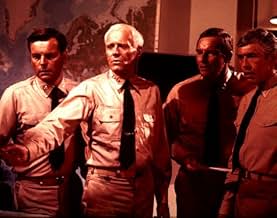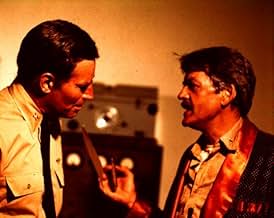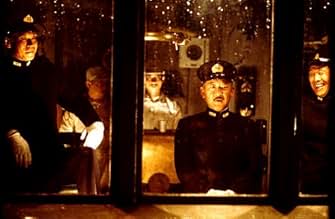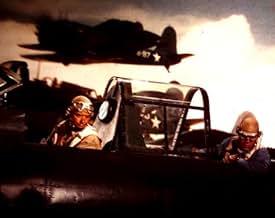NOTE IMDb
6,8/10
22 k
MA NOTE
Une dramatisation de la bataille qui fut le moment décisif du Pacifique durant la seconde guerre mondiale.Une dramatisation de la bataille qui fut le moment décisif du Pacifique durant la seconde guerre mondiale.Une dramatisation de la bataille qui fut le moment décisif du Pacifique durant la seconde guerre mondiale.
- Réalisation
- Scénario
- Casting principal
Toshirô Mifune
- Admiral Isoroku Yamamoto
- (as Toshiro Mifune)
Avis à la une
Like "The Longest Day" and "Tora! Tora! Tora!", "Midway" follows the true story very closely and features an all star cast. And like the Longest Day, it features Henry Fonda, Robert Mitchum, and Robert Wagner. However, whereas the first two are war classics, Midway falls short in many departments.
For one, the movie seems to have no sense of building suspense. In the Longest Day, the paratrooper landings and the scenes of bombardment vessels creeping toward the shore let you know that all hell is about to break loose. Likewise, in Tora! Tora! Tora!, scenes of anxious commanders, desperate analysts, and the oblivious Hawaii residents are separated by scenes of approaching Japanese bombers to hike the suspense factor. Yet, despite the fact that Midway was the most decisive naval battle in modern history, we don't get a true sense of how important the pilots' jobs are or how grave the implications of the battle are, except for from titles before and after the movie. Where were the scenes of planes prepping for takeoff or of pilots, wary but dutiful about a mission that may be their last?
The battle sequences are another problem. First off, most of the footage is actual war footage or stock footage. The stock footage works fine for the bombing of Tokyo (since the shown footage is actually about that event) but is a little less convincing when the footage shown is supposed to be of Hawaii's Hickam Field but is passed off as Midway Island. Worse than the presence of stock footage is the editing. While maps of the ocean are shown repeatedly so that we know where the action is taking place, it's hard to tell what's what when we're away from the maps. We see planes crash into water and bombs explode, but most of the battle sequences could use a little more coherence. Had the makers of this movie shot a little combat footage of their own, even if only to make the battle scenes less jump, the movie would have benefitted.
For the most part, the cast is pretty good and fares well with only occasionally trite dialogue. However, only Heston, Holbrook, and Shigeta stand out. Many of the other players are simply not given enough time to make an impact. Coburn, especially, has little to do.
The flaws of this movie notwithstanding, it's still watchable, and it gives you a pretty good idea of the events and decisions leading up to the battle, as well as the errors and luck that went into the battle itself. And when you can't figure out what's happened from the uneven visuals, at least Nimitz (Fonda) or his at-sea commanders are there to describe what happened and add some perspective.
** out of ****
For one, the movie seems to have no sense of building suspense. In the Longest Day, the paratrooper landings and the scenes of bombardment vessels creeping toward the shore let you know that all hell is about to break loose. Likewise, in Tora! Tora! Tora!, scenes of anxious commanders, desperate analysts, and the oblivious Hawaii residents are separated by scenes of approaching Japanese bombers to hike the suspense factor. Yet, despite the fact that Midway was the most decisive naval battle in modern history, we don't get a true sense of how important the pilots' jobs are or how grave the implications of the battle are, except for from titles before and after the movie. Where were the scenes of planes prepping for takeoff or of pilots, wary but dutiful about a mission that may be their last?
The battle sequences are another problem. First off, most of the footage is actual war footage or stock footage. The stock footage works fine for the bombing of Tokyo (since the shown footage is actually about that event) but is a little less convincing when the footage shown is supposed to be of Hawaii's Hickam Field but is passed off as Midway Island. Worse than the presence of stock footage is the editing. While maps of the ocean are shown repeatedly so that we know where the action is taking place, it's hard to tell what's what when we're away from the maps. We see planes crash into water and bombs explode, but most of the battle sequences could use a little more coherence. Had the makers of this movie shot a little combat footage of their own, even if only to make the battle scenes less jump, the movie would have benefitted.
For the most part, the cast is pretty good and fares well with only occasionally trite dialogue. However, only Heston, Holbrook, and Shigeta stand out. Many of the other players are simply not given enough time to make an impact. Coburn, especially, has little to do.
The flaws of this movie notwithstanding, it's still watchable, and it gives you a pretty good idea of the events and decisions leading up to the battle, as well as the errors and luck that went into the battle itself. And when you can't figure out what's happened from the uneven visuals, at least Nimitz (Fonda) or his at-sea commanders are there to describe what happened and add some perspective.
** out of ****
I first saw this movie when it was opening as a 10 year old boy who was enamored with WWII. At that time to me, it was one of the best war movies I had ever seen. Due to my prior readings on the battle, I knew it followed the history fairly well, and I was able to tune out the romance sub plot. The look of movie was something that was something I was not familiar with in war movies up to that point. The indoor officers were in nice neat uniforms, while the pilots, Marines, and common sailors had a weary rumpled look. And the language! I had not yet heard so much cursing in a war movie (it was 1976 and for the most part John Wayne type movies were the norm). But I loved it all! I knew most of the planes shown on screen were not accurate, and much of the combat footage was from later in the war. But it showed a different type of war movie. The Japanese were strong, smart, and nearly invincible. Not monsters or maniacs, but allowing overconfidence at times to cloud some decisions. The Americans were brave, novices, unsure of themselves at times, yet determined not to fail, no matter the cost. Not the overpowering unbeatable force of years to come later in the war. Watching during the initial phases of combat as obsolete US planes were shot down one by one by the superior Japanese fighters, I was captivated by the self sacrifice(a year later the ending dogfight in Star Wars would make me think of Torpedo 8). Then the tide turned as events, luck, and timing change the course of battle. In the end, the US wins, the Japanese are defeated, and survivors ponder the results and reasons why briefly. Flash forward 32 years later and I watch this movie again on my DVD copy on the 66th anniversary of the battle. This movie holds up not too badly against the test of time. Much time has passed in by movie making and in my gaining knowledge of this subject. To me the strengths still hold, as do the weaknesses. The interracial romance subplot is certainly a 70s addition. Certainly not believable in a historical context. The stock footage of aircraft certainly still glares in error as well. Color footage was shot during the battle and released in a documentary. A small amount was incorporated into the movie. Much more could have replaced other sequences that were used in the movie. Many of the Tora!Tora!Tora! conversion aircraft were still local to Universal Studios at Orange County or Chino airports at the time of filming. Some were used in the Midway Island bombing sequence, but not in the Yorktown attacks. Too bad they did not make more use of them for a better look. The Japanese film sequences from "Storm Over the Pacific" actually worked very well for their capturing the look of the Japanese carriers and the activities on board. As did the lifted opening from "30 seconds Over Tokyo". Much of the dialog on film is true to life with certain quotes historically accurate. "Look at that b*****d burn", was the first radio message clearly heard on the US carriers letting them know any of the air strikes had made contact and been successful. It also holds up sticking fairly close to the time line of actual events, but there are several events omitted. Finally the effects were not bad. For pre CGI the choices are to build full scale mocks ups, use an area or item that has a resemblance or miniatures. All three methods were used to good effect. And the results were for the most part just as good as, if not better than the more modern (film making wise) CGI heavy "Pearl Harbor". All in all, a decent war movie, still worth watching, flaws and all.
A critical part of WWII gets the big epic cinematic treatment, with all star casting and lots of noise. Though purporting to be exactly how things were during this particular battle, a pinch of salt is also needed. Much of the film is taken up with laying foundations for the air-sea engagement of the title, political posturing and military machinations are joined by needless sub-plots. The dialogue is often cheese laden, some characterisations equally so, while the splicing of real life footage and other war movie moments start to detract. However, the last third of film is thrilling and worth waiting for, a whirl of battle action as the Pacific conflict comes vividly to life both visually and aurally. 6.5/10
The film Midway shows in graphic documentary style, the battle that did nothing less than save America and ultimately allow us to win World War II. If the Japanese had prevailed at Midway, they might very well have taken Hawaii and been blockading our continental Pacific coast. We might have had to declare a truce and hope that public opinion would allow us to continue the European and North African war. Remember the USA was brought in to the war because of the Japanese attack at Pearl Harbor, not Hitler's attack.
There is a plot of sorts with Charlton Heston as the fictional pilot group commander who's involved in helping his son Edward Albert help a Nisei family who've been interred for the duration of the war because Albert is engaged to the daughter. That's the one weakness of Midway, the story really wasn't necessary and detracted with the very precise telling of the Midway tale. Had they left it out, Midway had the potential to be a classic like The Longest Day.
Without Charlton Heston and his family problems, the story of Midway is told with remarkable historic accuracy. Henry Fonda who played Admiral Chester W. Nimitz in all but name in In Harm's Way, gets to play Nimitz again in Midway. Robert Mitchum and Glenn Ford play Admirals William Halsey and Raymond Spruance who between the two of them won America's Pacific war. A whole lot of fine character actors like James Coburn, Robert Wagner, Robert Webber, Hal Holbrook and many more fill their naval roles to precision.
The story of the Battle of Midway should be told and told again in America's public schools for future generations. Not just because of the sailors and airmen of America's greatest generation who fought and prevailed at Midway, but because of just how close a run thing the Battle of Midway was. One very fateful decision by Admirals Yamamoto and Nagumo turned the tide of battle on a dime. By the way the oriental players in Midway like Toshiro Mifune as Yamamoto and James Shigeta as Nagumo and others also play very well. The American cinema certainly came a long way from when they previously cast the Japanese as bucktooth primates.
When the viewer sees just how much pure luck played a part in winning at Midway, they will come away with one of two impressions. The first might be that a divine providence is guiding and protecting America. If so, who's to say that will always be the case. And if not, the second lesson might be that we as a country might not always be so lucky.
If they could edit out the Heston family story, Midway is a great film for history classes studying World War II.
There is a plot of sorts with Charlton Heston as the fictional pilot group commander who's involved in helping his son Edward Albert help a Nisei family who've been interred for the duration of the war because Albert is engaged to the daughter. That's the one weakness of Midway, the story really wasn't necessary and detracted with the very precise telling of the Midway tale. Had they left it out, Midway had the potential to be a classic like The Longest Day.
Without Charlton Heston and his family problems, the story of Midway is told with remarkable historic accuracy. Henry Fonda who played Admiral Chester W. Nimitz in all but name in In Harm's Way, gets to play Nimitz again in Midway. Robert Mitchum and Glenn Ford play Admirals William Halsey and Raymond Spruance who between the two of them won America's Pacific war. A whole lot of fine character actors like James Coburn, Robert Wagner, Robert Webber, Hal Holbrook and many more fill their naval roles to precision.
The story of the Battle of Midway should be told and told again in America's public schools for future generations. Not just because of the sailors and airmen of America's greatest generation who fought and prevailed at Midway, but because of just how close a run thing the Battle of Midway was. One very fateful decision by Admirals Yamamoto and Nagumo turned the tide of battle on a dime. By the way the oriental players in Midway like Toshiro Mifune as Yamamoto and James Shigeta as Nagumo and others also play very well. The American cinema certainly came a long way from when they previously cast the Japanese as bucktooth primates.
When the viewer sees just how much pure luck played a part in winning at Midway, they will come away with one of two impressions. The first might be that a divine providence is guiding and protecting America. If so, who's to say that will always be the case. And if not, the second lesson might be that we as a country might not always be so lucky.
If they could edit out the Heston family story, Midway is a great film for history classes studying World War II.
Of course "Midway" is a flawed movie. The subplot about Japanese-Americans is ridiculous and seems like a forced attempt to be PC during the post-Vietnam 1970s when it wasn't in fashion to be completely celebratory of America. Of course it's unsatisfying that the Japanese actors don't speak Japanese and we have to hear Paul Frees dubbing Toshiro Mifune. Of course the stock footage isn't going to please aviation and naval buffs who know these details like the back of their hands, but to me this is a trivial complaint that fails to take into account the limits of 1970s technology or budgeting. "Pearl Harbor" ultimately got those details right through CGI and the end result was a far worse film in the final analysis. Because ultimately, for all the flaws that are in "Midway" it succeeds because it does stick to the essential truths when telling the story of the battle, and I know this because when I first saw this movie on the CBS Late Movie around 1979, I got so hooked that I went out and read every book on the battle I could find including Walter Lord's "Incredible Victory." The movie had given me a starting reference point and while I was sorry that some key aspects of the latter stages of the battle were not depicted (such as the torpedoing and eventual sinking of the Yorktown), I couldn't have asked for anything better in terms of getting me to learn more about this great turning point of World War II. As far as I'm concerned, it's good that Hollywood did tackle this subject in an era when the influence of "Tora! Tora! Tora!", "The Longest Day" etc. still hung over the proceedings because if it hadn't been made back then, we would today be forced to see it given the "Pearl Harbor" and "Titanic" treatment that is pure garbage.
John Williams contributes one of his finer pre-Star Wars scores with two great themes, the "Midway March" (which is only heard in the end credits of the theatrical version and became more popular in an expanded concert arrangement by the Boston Pops) and the "Men Of The Yorktown March" which dominates much of the score and offers great foreshadowings of the Throne Room sequence in "Star Wars" and the Smallville music in "Superman."
John Williams contributes one of his finer pre-Star Wars scores with two great themes, the "Midway March" (which is only heard in the end credits of the theatrical version and became more popular in an expanded concert arrangement by the Boston Pops) and the "Men Of The Yorktown March" which dominates much of the score and offers great foreshadowings of the Throne Room sequence in "Star Wars" and the Smallville music in "Superman."
Le saviez-vous
- AnecdotesKevin Dobson's character Ensign George Gay, was the sole survivor of Torpedo Squadron 8. Gay wrote a book about his experiences (Sole Survivor) and was an advisor on this film.
- GaffesWhen the cockpit of one of the planes catches fire, the pilot pulls out a fire extinguisher. It is a more modern one, not a fire extinguisher that would have existed in the 1940s.
- Citations
Vice Adm. Chuichi Nagumo: [commenting on the American torpedo bombers] They sacrifice themselves like samurai, these Americans.
- Versions alternativesA television version exists, with additional cast and plot. It runs four hours with commercials. The main plot points are a Charlton Heston-Susan Sullivan romance and the Coral Sea battle (reffered to in the other version) is played out like the Midway battle. The Coral Sea battle heavily features Mitchell Ryan as Admiral Aubrey Fitch and also includes a subplot where a young Japanese pilot who'd met with Admiral Nagumo to express his opposition to Japanese military action is shot down. At the end of the TV version, Sullivan and Christine Kukobo are both shown waiting dockside.
- ConnexionsEdited from Salute to the Marines (1943)
- Bandes originalesIn the Mood
Music by Joe Garland
Performed by the Glenn Miller and His Orchestra (as Glenn Miller Orchestra) on the jukebox at the bar in Hawaii
Meilleurs choix
Connectez-vous pour évaluer et suivre la liste de favoris afin de recevoir des recommandations personnalisées
- How long is Midway?Alimenté par Alexa
Détails
Box-office
- Montant brut aux États-Unis et au Canada
- 43 220 000 $US
- Week-end de sortie aux États-Unis et au Canada
- 4 356 666 $US
- 20 juin 1976
- Durée2 heures 12 minutes
- Couleur
- Rapport de forme
- 2.39 : 1
Contribuer à cette page
Suggérer une modification ou ajouter du contenu manquant

Lacune principale
By what name was La bataille de Midway (1976) officially released in India in English?
Répondre





































